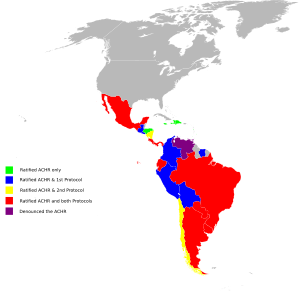American Convention on Human Rights
The American Convention on Human Rights (AMRC) was signed in 1969 in San José . It came into force after the last of the eleven signatory states, Grenada , ratified it in 1978 .
Content and goals
According to the preamble, the declared aim of the convention was to integrate the continent through the strengthening of democratic institutions and human rights.
In the first chapter, the signatory states were obliged to apply the provisions of the convention to all persons under the jurisdiction of these states. The legislation should be adapted to the convention. The second chapter listed 23 rights of natural persons such as freedom of expression and freedom of assembly . The only article in the third chapter deals with economic and cultural rights.
Signatory (States)
- Argentina
- Barbados
- Bolivia
- Brazil
- Chile
- Costa Rica
- Dominica
- Dominican Republic
- Ecuador
- El Salvador
- Grenada
- Guatemala
- Haiti
- Honduras
- Jamaica
- Colombia
- Mexico
- Nicaragua
- Panama
- Paraguay
- Peru
- Suriname
- Trinidad and Tobago
- Uruguay
- Venezuela
Additional protocols
The 1990 protocol to the American Convention on Human Rights on the Abolition of the Death Penalty has only been ratified by eight American states and signed by nine. In 2004 there was no signature or ratification .
The protocol to the American Convention on Human Rights permits the death penalty in wartime as an exception if states make a corresponding reservation.
See also
Web links
- BASIC DOCUMENTS PERTAINING TO HUMAN RIGHTS IN THE INTER-AMERICAN SYSTEM (English)
- DOCUMENTOS BÁSICOS EN MATERIA DE DERECHOS HUMANOS EN EL SISTEMA INTERAMERICANO (Spanish)
- DOCUMENTS DE BASE CONCERNANT LES DROITS DE L'HOMME DANS LE SYSTÈME INTERAMÉRICAIN (French)
- DOCUMENTOS BÁSICOS EM MATÉRIA DE DIREITOS HUMANOS NO SISTEMA INTERAMERICANO (Portuguese)
